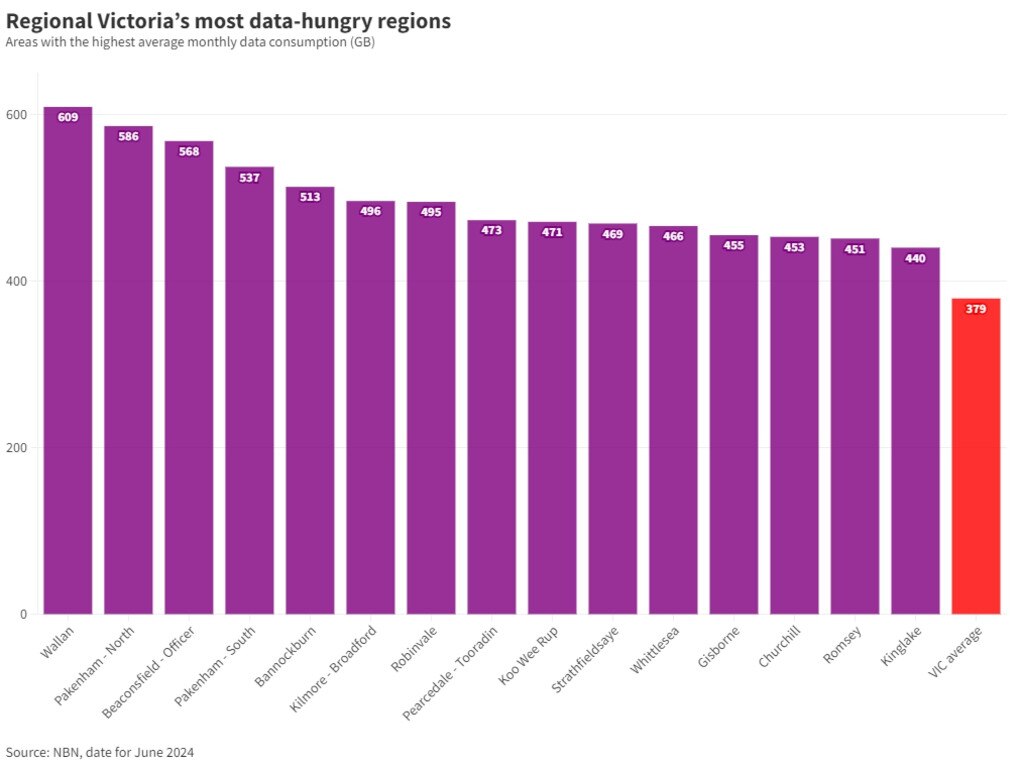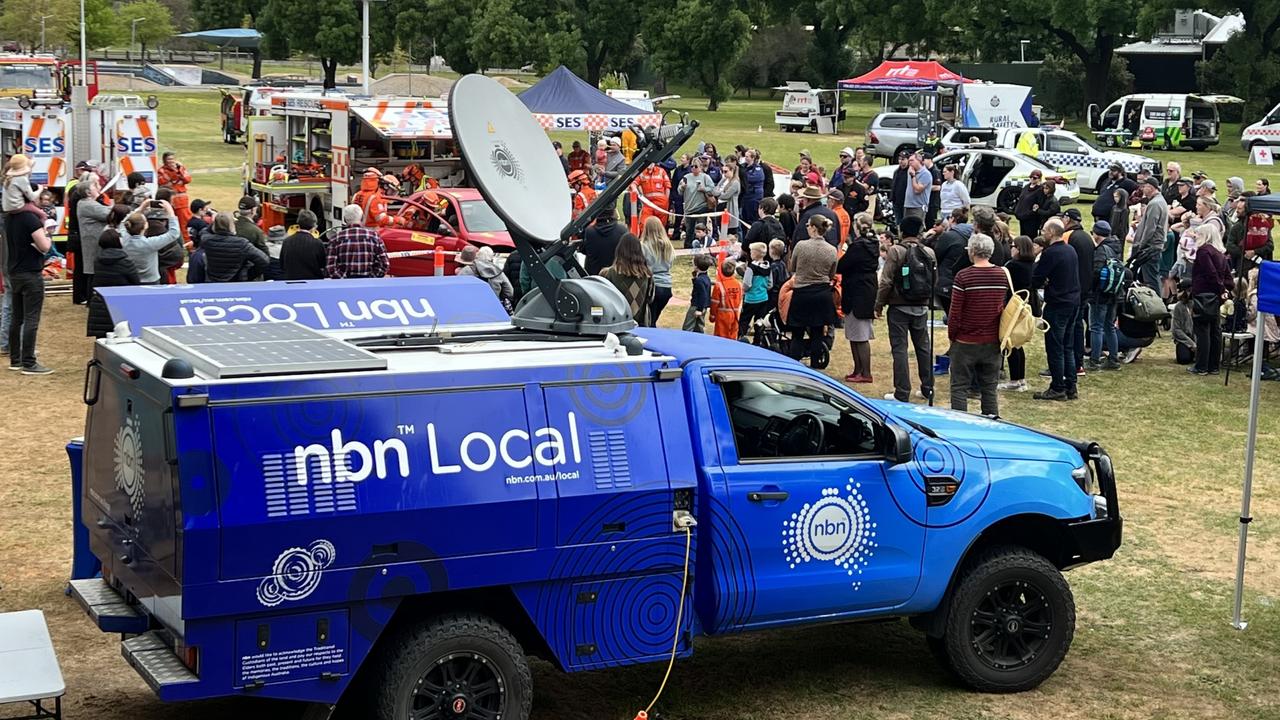Revealed: Victorian regions eligible for faster internet with NBN upgrades
Thousands of Victorian households are unnecessarily missing out on perks like buffer-less Netflix and instant downloads because they haven’t upgraded their NBN. Find out if you’re eligible.
Victoria
Don't miss out on the headlines from Victoria. Followed categories will be added to My News.
Too many Australians are “missing out” on faster internet, languishing on the equivalent of 3G speeds despite millions of households being eligible for upgrades.
This is the view of Rob Joyce – the NBN’s head of customer strategy and innovation, and former chief technology officer at Nokia Oceania – who is urging all Aussies to “check their speeds”.
Residents of regional areas, in particular, should enter their addresses into the NBN website to determine whether they could apply for upgrades that could be life-changing, Dr Joyce said.
About 403,000 households in Victoria will be eligible to shift from old copper cables to “state-of-the art fibre-optic cables” by the end of 2025.
More than a quarter of those are in the Latrobe-Gippsland region, followed by the Bendigo (57,000), Hume (56,000) and North West (52,000) areas. Almost 50,000 households across Victoria’s two largest regional cities, Geelong and Ballarat, can apply for upgrades, too.

“Households can move from 10s of megabits per second … to close to 1000 megabits per second (or 1 gigabit), from the dark old internet days where your Netflix streaming is going to be a bit blurry to multiple TVs running buffer-less 4K Netflix in a household,” Dr Joyce said. “It’s literally click the movie and it plays instantly.
“They will download PowerPoint presentations in the blink of an eye (and) game patches in minutes, not hours.”
The internet was now “a critical service, like water and electricity”, he said. This was especially true for households in remote areas that depended on the web to work from home, access e-commerce and e-health services, keep their houses safe via security cameras, and connect with family and friends.
The average regional Victorian home has 22 internet-connected devices, according to NBN.
Several postcodes are also using well above the statewide average 379GB of data per month – the equivalent of streaming HD video for 129 hours. These are led by Wallan (609GB monthly average per household), Pakenham North (586GB), Beaconsfield-Officer (568GB), Pakenham South (537GB) and Bannockburn (513GB).


The NBN expects these numbers to grow as residents increasingly access remote health services, 4K streaming for entertainment, remote work applications like video conferencing, and technology to make their homes safer and energy efficient.
Nationwide, gamers drove the top five biggest data traffic days on the NBN network last year, and streaming is the No.1 overall use of the network. Web browsing and social media usage are also big contributors.
Victorians eligible for NBN fibre upgrades need to place an order for a high-speed plan of at least 100 megabits per second through an internet provider, and then ensure their Wi-Fi set up was “fit for the future”, Dr Joyce said. The upgrade typically takes four to six weeks from order to completion.
He said fibre connections were eight times more reliable than the existing copper telephone lines and at least 15 times faster than the average NBN home broadband connection. More than 16,500 homes and businesses in regional Victoria have already ordered an upgrade.
Dr Joyce said NBN planned to have fibre connections available to more than seven million Australian households by the end of next year. Significantly faster speeds were also on the horizon, as NBN prepared for the future of technology.

“Our fibre network is capable of 80 gigabits per second – we set the world record a couple of weeks ago on our network during a trial with Nokia. So speeds of 80 gigabits and beyond will be achievable in the future,” he said.
“4K streaming is driving demand on our network, and we’re even beginning to see 8K come down the line.
“AI is also going to feature heavily, so are spatial videos – that’s wraparound 360 video, the sort of thing that you can watch using the new Apple Vision Pro, which we estimate will need at least 100 megabits per second.
“So we certainly see a need to upgrade regional Victoria to fibre, because a lot of these services of the future just won’t be able to be delivered using old copper telephone lines at 3G speeds.”
Am I eligible for internet upgrades?
The Victorian regions where households are eligible for full-fibre NBN upgrades by the end of 2025
Latrobe–Gippsland: 112.5k households
Bendigo: 57.5k
Hume: 56k
North West: 52k
Warrnambool and South West: 42.5k
Ballarat: 32k
Geelong: 17.5k
Melbourne-North West: 8k
Shepparton: 25k
VIC total: 403k
What to do if you’re in these regions
1. Check if you are eligible for a full-fibre upgrade by entering your home address at nbnco.com.au/check
2. If you are eligible, place an order for high-speed plan (at least 100Mbps) through an internet provider and NBN will work with them to build fibre straight to your door
Victoria’s most data-hungry regions
Areas with the highest average monthly data consumption in June
Wallan: 609 GB
Pakenham North: 586 GB
Beaconsfield-Officer: 568 GB
Pakenham South: 537 GB
Bannockburn: 513 GB
Kilmore-Broadford: 496 GB
Robinvale: 495 GB
Pearcedale-Tooradin: 473 GB
Koo Wee Rup: 471 GB
Strathfieldsaye: 469 GB
Whittlesea: 466 GB
Gisborne: 455 GB
Churchill: 453 GB
Romsey: 451 GB
Kinglake: 440 GB
VIC average: 379 GB
Source: NBN
How NBN has become vital during fires, floods, storms
Jen Kelly
Hi-tech mobile satellites have become vital to restoring communications in disaster zones, as the NBN plays a growing role during major Victorian emergencies.
The NBN has developed a versatile fleet of vehicles and equipment to rapidly deploy to communities after bushfires and natural disasters to connect emergency Wi-Fi.
NBN regional manager Jennifer Ganske said satellite trucks and mobile satellites could be sent to quickly restore phone and internet services.

“We can go in and support communities to offer emergency Wi-Fi at the request of emergency services,” she said.
“When you all of a sudden realise you don’t have any connectivity, to be able to access that and ensure your loved ones are OK is invaluable.
“It creates relief, it makes people have a little bit of safety in something that can be really traumatic.”
During the January floods in central and northern Victoria, the NBN restored almost 8000 disrupted services at 134 sites over nine days.

In one innovative case, the NBN used a drone to fly across the flooded Goulburn River at Seymour after 700 homes and businesses lost internet access.
The drone flew a rope across the river after the NBN cable was severed, then a fibre optic cable was attached and winched across to restore the internet connection.
In February, NBN teams also provided emergency Wi-Fi during the Grampians bushfires and major storms in Mirboo.
The NBN’s support to emergency services and communities is expected to become more important as Australia faces natural disasters year round.
While mobile phone services are usually lost during emergencies, victims can regain access once emergency NBN Wi-Fi is connected at evacuation centres.
Ms Ganske urged Victorians to keep mobile phones charged and prepare an emergency kit, including a phone battery, charger, battery-powered radio with spare batteries or solar-powered or wind-up radio, prescriptions, and torch and batteries.
Residents should also upload ID and essential documents such as insurance policies to the cloud or keep on a USB.
“In order to receive some of the emergency funding, if you are at an evacuation centre, you have to have proof of where you live and who you are,” Ms Ganske said.
Originally published as Revealed: Victorian regions eligible for faster internet with NBN upgrades







